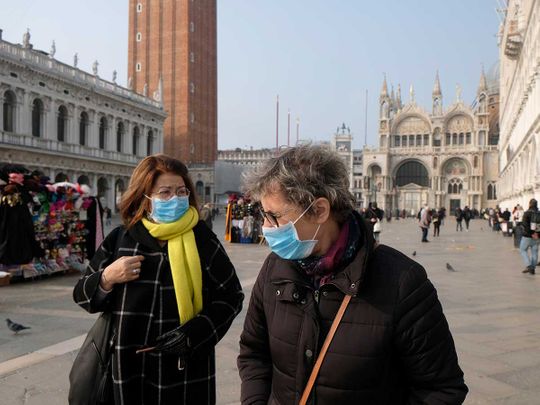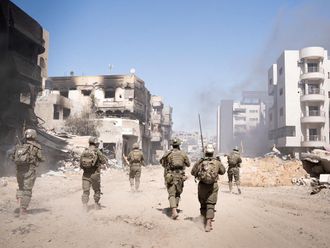
A great many Italians seem to be confused. Most of us don’t know what to think. Mood swings are obvious around any dinner table. Is coronavirus just a nasty flu, and we are overreacting? Or are we facing a serious epidemic and there are plenty of reasons to be worried?
On Friday I met with friends who run a charming hotel on the hills near Parma; all the bookings from abroad have been cancelled. I drove two of my friends to Linate Airport the next day. Autostrada del Sole and Milan’s beltway, always busy, looked like highways in Utah: almost empty. So did the city airport.
In conversations, scary jokes mix with half-digested scientific data. Virologists — who try to explain what is going on and, more important, what to expect — have become household names. Sometimes they quarrel with one another, adding confusion to the mix.
Italy is living in a strange, suspended time. Milan, its most energetic city, seems anxious to get back to business as usual, but that won’t be quick, nor easy. The country holds its breath and waits.
So Italians are muddled and scared, no wonder. The news media talk about nothing else, and add alarming images to make their point. We see more masks on TV and online than on the streets of Milan — half-deserted streets, with many people staying home. Schools and markets are closed, and many events cancelled.
The mayor, Beppe Sala, is trying to spur a reaction; a video labelled #Milanononsiferma (Milan Doesn’t Stop) went viral. But it’s going to be a struggle. Many countries are restricting travel to and from Italy, leaving a feeling of isolation that feeds unease.

Sizeable outbreak
The numbers of the infected are small, compared to China, where the coronavirus started. In Italy, as of Sunday, 1,694 people had tested positive to the new virus. More than half live in Lombardy, and about 270 each in Veneto and Emilia-Romagna. Forty-one have died; their average age is around 80.
Six hundred and forty are hospitalised. One hundred and forty are in intensive care. Eighty-three have recovered. Most have shown mild symptoms or none, which makes it more difficult to detect who is infected.
Nonetheless, Northern ltaly was the first place in Europe to spot a sizeable outbreak. What can we learn from that? How does a new virus affect a modern European country, with a democratic government and lively public opinion?
Italy’s lifestyle is closer to the rest of Europe’s than those of China or South Korea, which were the first countries to be seriously affected by the virus. Population numbers, density and distances to travel differ as well, as do social norms and health care.
How can Italy’s National Health Service — widely considered among the world’s best — cope with a potentially enormous number of patients? As of now, the threat has not materialised. To be sure, hospitals in Cremona and Lodi, where many patients are under intensive care, say they can’t take any more. But that is not the norm, as the country strains to avoid having too many people falling sick at the same time.
A vulnerable country
The spread of coronavirus has revealed an unusually vulnerable Italy. Not only up north, where so far the two hot spots seem to be the only ones. Most Italians have no direct experience of wars or epidemics, so they struggle to find a suitable reaction. The impulsive mood of recent politics seems to have found fertile terrain, putting Italy in the grip of some sort of health populism triggered by fear, alarm and hasty information, with fear turning into panic, and prudence into diffidence and political squabble.
Italy is not on the verge of collapse. Nevertheless, minimising what’s happening would be wrong. Ten municipalities around Codogno, a town of 15,000 southeast of Milan, are in lockdown: Nobody can get in or out. The first person in Italy known to have contracted coronavirus was diagnosed by the local hospital, and the government in Rome — together with Lombardy’s, Veneto’s and Emilia- Romagna’s regional authority — decreed exceptional measures to stop the epidemic from spreading: Schools are closed and will stay so for another week.
So are markets, cinemas, theatres, churches and museums. Football matches have been cancelled. Design Week, which attracts visitors to Milan from around the world, has been postponed from April to June. Public transport is half empty.
Furious fallout
For a society like Italy, keeping company with others is better than sedatives, and if you have to do without, you suffer withdrawal symptoms. So there may be furious fallout.
People have stopped shaking hands, let alone greeting each other with a kiss. If you sneeze or cough in public, people jerk away and show genuine alarm. Conversation is monopolised by coronavirus, and in the absence of clear rules, companies and organisations behave randomly. Why are people allowed to squeeze into a supermarket but are kept out of theatres?
Mistakes were made, probably, in late January. Italy may have been ill advised to stop flights to and from China; those flights would have provided a clear indication of who was arriving from that country, making health checks easier.
But in the last week, the government in Rome and the regional governments in Northern Italy took a firmer stand to slow down contamination, with the approval of the World Health Organisation and the European Union. Apart from the limitations already mentioned, two weeks of voluntary self-quarantine has been requested from anyone who has had direct contact with people who tested positive for coronavirus.
But drastic measures without clear explanations have scared the nation. It would be wise to say, over and over, that it is crucial to limit the number of people who can pick up the virus from an infected person; and to do that, for a time, you will have to keep people apart.
Moreover, the Italian health system has broadened its testing beyond only people with symptoms who have been in contact with infected coronavirus subjects. As of Sunday, Italy had tested about 20,000 people, many more than France or Germany. So it is hardly surprising that Italy is registering more positive cases.
Confusion reigns
Of course, confusion reigns when a new situation arises, but the last ten days have already transformed Italy into an intriguing political, commercial, social, and psychological laboratory.
The first Western country to deal with coronavirus en masse has also spotlighted how sensitive democracies are, even in developed states: their inappropriate initial reaction toward China, a crucial trade partner; the failure to gauge the economic impact; the reluctance of many companies to adopt smart working practices; the lack of solidarity within national borders. Also, the sudden pressure on the National Health Service.
And above all, the personal vulnerability shown by many. This is the first epidemic to land on social media, where people can warn, but also scare, one another.
Italy is living in a strange, suspended time. Milan, its most energetic city, seems anxious to get back to business as usual, but that won’t be quick, nor easy. The country holds its breath and waits.
Seven centuries ago, Giovanni Boccaccio, a founding father of the Italian language, used the plague (the real one) as inspiration for his masterwork, “The Decameron.” In it, 10 young people take refuge in a country villa to escape contagion, and tell stories to pass the time. Today they would be posting nonsense on Facebook, ramping up fear in folks who are already afraid.
NYT
Beppe Severgnini is a noted Italian journalist, essayist and columnist









